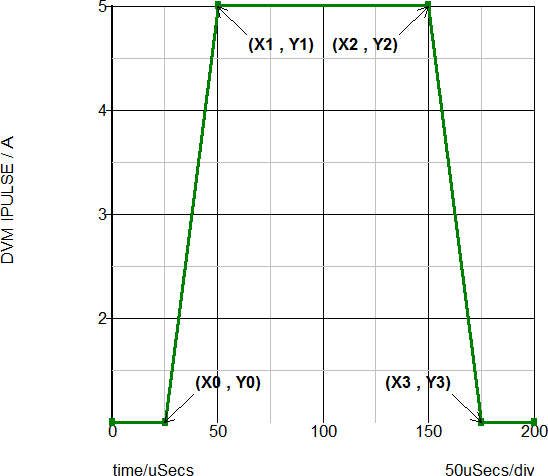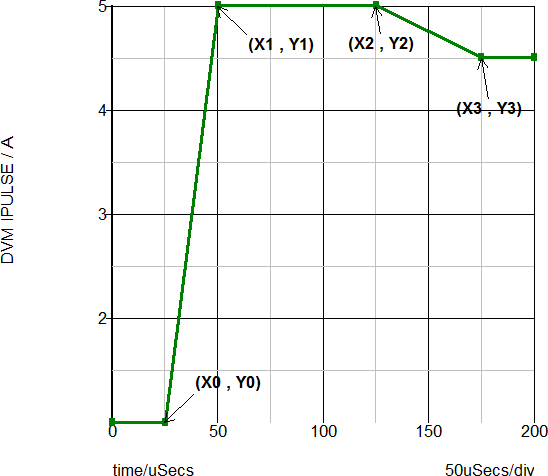DVM - Design Verification Module
|
The Pulse Load - Single Pure Current Pulse subcircuit models a single pulse without a resistive load. For a single current pulse load with a resistive component, see the Pulse Load - Single Current Pulse. This load is not used in any test objectives, but you can set any managed DVM load to use this subcircuit with a PulsePure() call in the Load column of your testplan.
In this Topic Hide
The table below explains the parameters used in the Pulse Load - Single Pure Current Pulse subcircuit.
Parameter Name |
Default |
Data Type |
Range |
Units |
Parameter Description |
FALL_TIME |
50u |
Real |
min: 0 |
s |
The pulse fall time in seconds |
FINAL_CURRENT |
750m |
Real |
min: 0 |
A |
The final current for the load. The Pulse Load - Single Pure Current Pulse continues at this current for all simulation times greater tha TIME_DELAY+RISE_TIME. This can be a numeric value or a symbolic value, such as a percentage of full load. |
LOAD_NAME |
LOAD |
String |
n/a |
n/a |
Name of the DVM load. This name cannot contain spaces. |
PULSE_CURRENT |
250m |
Real |
min: 0 | A | The pulsed current in amps. The pulse current can be a numeric value or a symbolic value, such as a percentage of full load. |
PULSE_WIDTH |
200u |
Real |
min: 0 |
s | The pulse width in seconds. Note that DVM considers the pulse width to be the duration of the pulse at the PULSE_CURRENT. |
RISE_TIME |
100u |
Real |
min: 0 |
s |
The pulse rise time in seconds |
START_CURRENT |
0 |
Real |
min: 0 |
A |
The starting current for the load. This can be a numeric value or a symbolic value, such as a percentage of full load. |
TIME_DELAY |
10u |
Real |
min: 0 |
s |
The time delay before the pulse initiates |
To set any managed DVM load to a Pulse Load - Single Pure Current Pulse subcircuit, place a PulsePure() testplan entry in the Load column.
The PulsePure() testplan entry has the following syntax with the arguments explained in the table below.
PulsePure(REF, START_CURRENT, PULSE_CURRENT,
FINAL_CURRENT)
PulsePure(REF, START_CURRENT, PULSE_CURRENT,
FINAL_CURRENT, OPTIONAL_PARAMETER_STRING)
where:
| Argument | Range | Description |
REF |
n/a |
The actual reference designator of the DVM load or the more generic syntax of OUTPUT:n where n is an integer indicating a position in the list of managed DVM loads. |
START_CURRENT |
min: 0 |
The starting current for the load. This can be a numeric value or a symbolic value, such as a percentage of full load. |
PULSE_CURRENT |
min: 0 |
The pulse current for the load. This can be a numeric value or a symbolic value, such as a percentage of full load. |
FINAL_CURRENT |
min: 0 |
The final current for the load. This can be a numeric value or a symbolic value, such as a percentage of full load. |
OPTIONAL_PARAMETER_STRING |
n/a |
Parameter string with a combination of one or more timing parameters:
|
* If more than one parameter is specified, join the parameter key-value pairs with a space, as shown in the example below. The order of the parameter names does not matter.
The timing for the Pulse Pure Load is determined by the following parameters.
Timing parameters can be assigned using the optional parameter string as shown in the following examples.
This example shows a symmetric pulse with equal rise and fall times. The final current is the same as the starting current.
| *?@ Load | ||||
|---|---|---|---|---|
| PulsePure(OUTPUT:1, 1, 5, 1, TIME_DELAY=25u RISE_TIME=25u PULSE_WIDTH=100u FALL_TIME=25u) | ||||
The results of this testplan entry are shown below:

| Annotation | Value |
| X0 | TIME_DELAY |
| X1 | TIME_DELAY + RISE_TIME |
| X2 | TIME_DELAY + RISE_TIME + PULSE_WIDTH |
| X3 | TIME_DELAY + RISE_TIME + PULSE_WIDTH + FALL_TIME |
| Y0 | START_CURRENT |
| Y1 | PULSE_CURRENT |
| Y2 | PULSE_CURRENT |
| Y3 | FINAL_CURRENT |
The following example sets the first DVM managed load to a Pulse Load - Single Pure Current Pulse, with a starting current of 1A, a pulse current of 5A and a final current of 4.5A. Note the rise and fall times are not the same and the pulse does not have to return to the starting current value.
| *?@ Load | ||||
|---|---|---|---|---|
| PulsePure(OUTPUT:1, 1, 5, 4.5, TIME_DELAY=25u RISE_TIME=25u PULSE_WIDTH=75u FALL_TIME=50u) | ||||
The results of this testplan entry are shown below:

| Annotation | Value |
| X0 | TIME_DELAY |
| X1 | TIME_DELAY + RISE_TIME |
| X2 | TIME_DELAY + RISE_TIME + PULSE_WIDTH |
| X3 | TIME_DELAY + RISE_TIME + PULSE_WIDTH + FALL_TIME |
| Y0 | START_CURRENT |
| Y1 | PULSE_CURRENT |
| Y2 | PULSE_CURRENT |
| Y3 | FINAL_CURRENT |
© 2015 simplistechnologies.com | All Rights Reserved